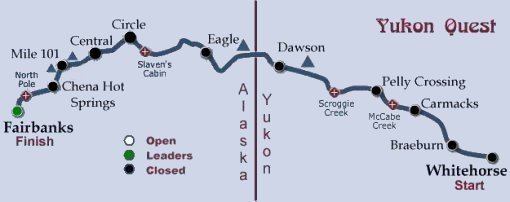Yukon Quest 2011 – Day 9

 Hugh Neff got into Circle after midnight my time and set out again this morning as temperatures in the -40s settled in over interior. [Note: -40° F = -40° C]
Hugh Neff got into Circle after midnight my time and set out again this morning as temperatures in the -40s settled in over interior. [Note: -40° F = -40° C]
In the current conditions people tend to move in groups as a matter of survival. While you see dogs riding around in the Lower 48 with their heads out the window, sled dogs as a group are not fond of running into the wind, especially at low temperatures. One of the keys to Lance Mackey’s success has been lead dogs that didn’t mind the wind and would run into it.
In addition to the biological component, the race reporting is suffering from equipment that doesn’t like the weather any more than the people. The Quest sites have been suffering periodic outages as 21st century tools attempt to work with 19th century infrastructure.
The race has transformed from a sprint to a slog since the Alaskan border and the weather change.
Update: 12:30PM CST
Sad News: Sled dog on Brent Sass’ team dies. It was a sudden death on the trail to Slaven’s Roadhouse, and a necropsy will be necessary to find the cause of death. For the moment Brent is continuing, but he may decide to scratch at Circle, which is on the road system.
Update: Brent lost his veteran wheel dog, Taco, just out of Trout Creek after a six-hour rest stop. The wheel dog is second only to the leader on a team. There was no indication of a problem at the stop. Taco was a 6-year-old male from Jessie Royer’s kennel as a puppy. Brent will be continuing.
Earlier, Brent and his team helped Hans Gatt in a very nasty situation: American Summit Rescue.
It is called sled dog racing because the dogs are the athletes. Sometimes a dog simply pushes too hard, beyond the capacity of their heart. They have been working extremely hard breaking trail through the snowdrifts, so they are giving it everything they have, and sometimes, more than they have.
Update: 11:30PM CST
Beyond Circle
1 Hugh Neff (8)
2 Hans Gatt (13) +5 hours 53 minutes
3 Sebastian Schnuelle (11)
4 Dallas Seavey (3)I
5 Allen Moore (24)IAt Circle
6 Dan Kaduce (10)
7 Ken Anderson (18)
8 Brent Sass (22)
9 Kelley Griffin (1)
10 Joshua Cadzow (16)Beyond Eagle
11 Mike Ellis (5)
12 David Dalton (23)
13 Jodi Bailey (17)RAt Eagle
14 Johannes Rygh (6)R
15 Tamara Rose (12)I
16 Jerry Joinson (21)R
17 Didier Moggia (7)
18 Kyla Durham (14)R
19 Hank DeBruin (19)IThe Mushers in bold are former winners of the Yukon Quest, the numbers in parentheses are their Bib numbers, the small “I” indicates a Quest rookie who has competed in the Iditarod, and the small “R” indicates a total rookie.
Note: This post will be updated during the day, and the map changed on all posts to reflect the current situation.
All posts on the Yukon Quest can be seen by selecting “Yukon Quest” from the Category box on the right sidebar.



































5 comments
yikes, hitting the reset button instead of the help button. definitely need better-designed gps units for stuff like this.
That was something that would not happen on military equipment. The various controls were different sizes, shapes, and colors to prevent mistakes like that. Normally a control like that would have a snap cover over it to prevent it from being used accidentally.
How common (or uncommon) is it for sled dogs to die in action? I know that Thoroughbreds because of their breeding are more susceptible to heart attacks. Is it the same case for top notch sled dogs?
It is very uncommon for the Yukon Quest. Three dogs died in 2007 and new rules imposing more mandatory stops for vet checks were imposed. One dog died in 2010, and the mushers pushed to have every dog checked by the same team of vets prior to the race. Before, teams were checked by different teams in Fairbanks and Whitehorse, or mushers could have their own vets certify to the health of the dogs.
The 2010 death was to a 7-year-old veteran dog that had a rare heart condition that was only discovered by necropsy. There was no way of determining the problem until after it occurred.
The worry is, that as certain teams predominate, there may be more inbreeding taking place, rather than the current status of sled dogs as mixed breeds. The more “purebred” the dogs become, the smaller the gene pool, the greater the chance for rare problems to become common, as has happened with Thoroughbreds.
There are two purebred teams in the race, Siberian huskies on the Mike Ellis and Hank DeBruin teams, but everyone else acquired dogs from different kennels over the course of years. Brent Sass got Taco in payment for working as a handler for Jessie Royer. That is not an uncommon practice.
The most common reason a sled dog dies is from aspiration pneumonia, they eat too fast and breathe in food particles which causes the fluid build up in the lungs.
Jessie Royer’s Kuling ran her last race as the lead dog when she was 9. She was in 7 Iditarods. Larry, Lance Mackey’s legendary lead, retired at 9 having been in 8 Iditarods and 4 Yukon Quests, and is the only lead dog to win the Quest and Iditarod Golden Harnesses in the same year, so 6-year-olds are not “over-the-hill”.
Dog deaths are way too common on the Iditarod, although there has been a real push to tighten things up considerably.
Thanks, Bryan. Interesting.